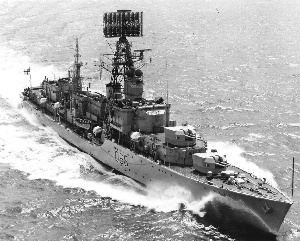Name HMS Barrosa Yard number 615 Commissioned 14 February 1947 Construction started 28 December 1943 Length 116 m | Ordered 1943 Laid down 28 December 1943 Decommissioned 1968 Launched 17 January 1945 Builder John Brown & Company | |
 | ||
HMS Barrosa (D68) was a later or 1943 Battle-class fleet destroyer of the Royal Navy.
Contents
Naming
She was named after the Battle of Barrosa, which took place in 1811 between British-Allied forces and France, and which ended in a French defeat. Barrosa was built by John Brown & Company. She was launched on 17 January 1945 and commissioned on 14 February 1947.
Operations
In 1948, Barrosa joined the 4th Destroyer Flotilla of the Home Fleet. In 1950, Barrosa with one of her sister-ships and the carrier HMS Vengeance, where the small group performed a number of naval exercises and visits to a variety of ports. Barrosa was placed in Reserve that same year.
In 1953, Barrosa took part in the Coronation Fleet Review at Spithead in honour of the newly crowned Queen Elizabeth II. Barrosa was positioned in the middle of her sister-ships HMS Aisne and HMS Agincourt. During the same year, Barrosa joined the 4th Destroyer Squadron, having spells with the Home and Mediterranean Fleets.
In November 1956 Barrosa formed part of the Royal Navy force deployed in the eastern Mediterranean during the Suez Crisis, as part of the 4th Destroyer Squadron.
Refit and conversion to radar picket
In 1959, Barrosa collided with her sister-ship HMS Corunna in the Atlantic. Later that year, Barrosa underwent modification to become a radar picket, with the addition of the Sea Cat missile, as well as new anti-aircraft weaponry and new radar. In 1962, Barrosa joined the 8th Destroyer Squadron (not verified), based in the Far East, before joining the 24th Escort Squadron. In 1968, Barrosa was decommissioned, being broken up at Blyth in Northumberland in 1978.
